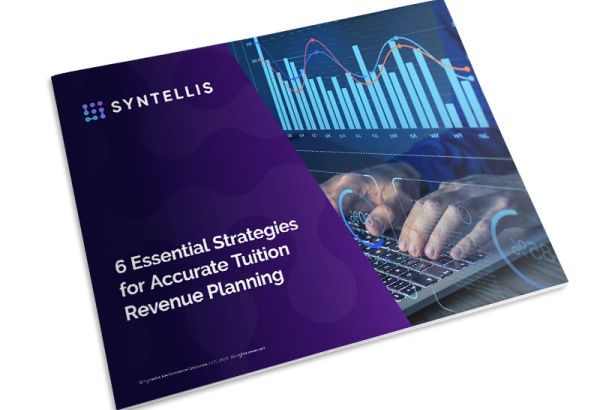Over the next five to ten years, financial leaders in higher education anticipate enrollment, labor costs, inflation, and funding to be among the industry’s top challenges to financial impact. And with more than six in 10 financial leaders (62%) stating that tuition and fees account for 50-90% of their institution’s revenue, colleges and universities face incredible uncertainty with the impending enrollment cliff.
David Moore, Chief Budget Officer and Associate Vice President of Financial Planning and Budgeting at Rutgers University, sees this firsthand.
“Enrollment is changing due to the trends that we've seen and introductions of new programs and degrees. We’ve been moving to multi-year enrollment planning to combat that,” Moore explained. “This helps us focus our efforts and understand how new changes or proposed changes would impact enrollment targets so that we can adjust where needed.”
Michelle Salo, Chief Operating Officer of Confederation Colleges, agrees, believing that everything should start with — and come back to — enrollment.
“Enrollment is a driver for us across the entire institution. By testing different enrollment scenarios and rolling labor, tuition, and grant data into the general ledger, we can see what each program will cost for the next few years – great for future planning amid uncertainty.”
Together, both Moore and Salo offered their thoughts on tuition revenue and fee strategies at Syntellis’ 2023 Higher Education Summit.
Q: What insights can you provide regarding tuition and enrollment at your institution?
Salo: In northwestern Ontario, we've seen a 40% drop in domestic students over the past eight years. Fortunately, we've been able to offset that 100% with growth in our international enrollment. The Ministry of Colleges and Universities sets specific tuition rates for colleges in Ontario, so we don't have the leverage to look at rates and determine how we might update them for domestic students. For international students, we have more flexibility.
Moore: Rutgers, like many other institutions, is not immune to some of the industry’s most pressing challenges. We have seen a trend where new resources from the state are likely linked to specific initiatives, which have their own costs to administer and operate. So, new funds are not coming in typically for unrestricted use for ongoing general operating needs, which puts further pressure on the tuition fees and enrollment planning overall. Enrollment trends, tuition fee planning, and the use of data play a large part in our budget and planning.
Q: What strategies are you deploying to mitigate enrollment declines?
Salo: Confederation College is focusing on supplementing international enrollment. We also have other strategies for micro-credentials or contract training programs where we deliver training specific to a community need in some of our northern communities with a large First Nation population. So, those two areas are really helping us to manage the enrollment declines on the domestic side.
Moore: Rutgers is enhancing offerings and reviewing enrollment planning and management efforts across campuses. We are also actively seeking to help students re-enroll post-pandemic so they can complete their degrees. We have strategies aimed at enrolling non-traditional students as well. And like Confederation, we are looking at certificates, credentialing programs, and course offerings as ways to help mitigate enrollment declines.
Q: How do you leverage scenario modeling to set your predictions?
Moore: At Rutgers, we develop several tuition rates throughout the year by benchmarking against our peers and looking at market analyses. With 29 schools and colleges offering over 150 undergraduate and over 400 graduate programs, we have a number of different rates, depending on the student.
Scenario planning empowers our teams to change rates and anticipated enrollment outcomes and see the impacts on the tuition revenue overall. Beyond the tuition rates, we can adjust retention rates to see how our students progress through their undergraduate and graduate years. This multi-year view of enrollment planning helps us understand how new or proposed changes would impact enrollment targets so that we can adjust accordingly.
Q: Which trends are essential to identify and understand for tuition planning?
Moore: At Rutgers, we can identify emerging trends by following revenue. We have three years of actuals, so we look at what's been loaded into our tuition planning module and track those course offerings. This provides valuable insight into demand and what students are looking for, like majors, interests in dual degrees, shifts from one school or college to another, etc. This information is beneficial in predicting how a first-year student would potentially progress through their years to degree completion.
Salo: Understanding student trends can help us predict our enrollment funnel. Where are students coming from? What do our high school trends look like? What is our market share, and what do we expect that to be five to 10 years from now?
We start in Axiom to assume what our first-semester enrollment will be. Eventually, we will be able to predict enrollment and what the pipeline will look like across programs based on our market share within our catchment area.
Q: Can you share any best practices regarding your tuition planning process and technology adoption?
Moore: One of the critical success factors is ensuring a process that supports the use of technology. Then, you need to understand what raw information feeds the models to ensure that we have reliable, repeatable data and not unhelpful information. Remember, end users at our campuses might not have used this technology before. They need to have adequate training and understanding of that technology.
Salo: Start with a vision. Ours was to go from tuition planning to program costing. We chose to implement Axiom because it would give us a comprehensive picture and allow data to flow seamlessly without having to import and export information regularly and perform analysis outside of the system. We can follow demand planning on the enrollment side and see financial reporting and program costs at the end of a period. From a budgetary perspective, it helps us get to that predictive level – to anticipate what we can expect in the next five years and the impact on program profitability.
Dig deeper into tuition revenue planning. Learn six best-practice strategies for overcoming common tuition planning challenges.
More on this topic...

6 Essential Strategies for Accurate Tuition Revenue Planning

Axiom Drives Fast, Accurate, and Flexible Tuition Planning at the University of Kentucky


